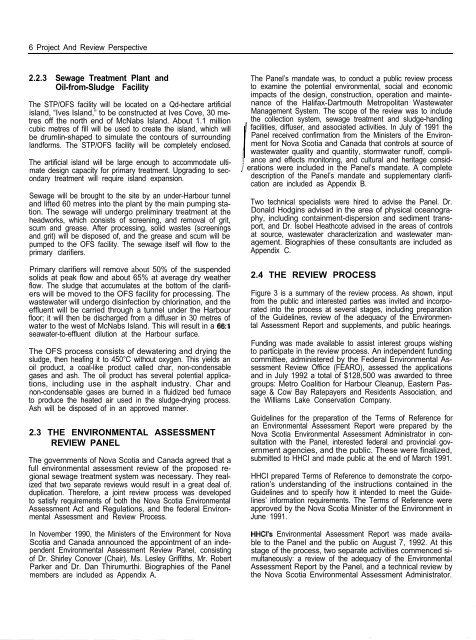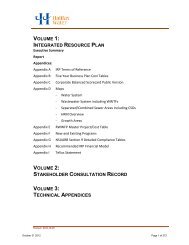Halifax Harbour Cleanup Inc. - Halifax Regional Municipality
Halifax Harbour Cleanup Inc. - Halifax Regional Municipality
Halifax Harbour Cleanup Inc. - Halifax Regional Municipality
You also want an ePaper? Increase the reach of your titles
YUMPU automatically turns print PDFs into web optimized ePapers that Google loves.
6 Project And Review Perspective<br />
2.2.3 Sewage Treatment Plant and<br />
Oil-from-Sludge Facility<br />
The STP/OFS facility will be located on a Qd-hectare artificial<br />
island, “Ives Island,” to be constructed at Ives Cove, 30 metres<br />
off the north end of McNabs Island. About 1.1 million<br />
cubic metres of fill will be used to create the island, which will<br />
be drumlin-shaped to simulate the contours of surrounding<br />
landforms. The STP/OFS facility will be completely enclosed.<br />
The artificial island will be large enough to accommodate ultimate<br />
design capacity for primary treatment. Upgrading to secondary<br />
treatment will require island expansion.<br />
Sewage will be brought to the site by an under-<strong>Harbour</strong> tunnel<br />
and lifted 60 metres into the plant by the main pumping station.<br />
The sewage will undergo preliminary treatment at the<br />
headworks, which consists of screening, and removal of grit,<br />
scum and grease. After processing, solid wastes (screenings<br />
and grit) will be disposed of, and the grease and scum will be<br />
pumped to the OFS facility. The sewage itself will flow to the<br />
primary clarifiers.<br />
Primary clarifiers will remove about 50% of the suspended<br />
solids at peak flow and about 65% at average dry weather<br />
flow. The sludge that accumulates at the bottom of the clarifiers<br />
will be moved to the OFS facility for processing. The<br />
wastewater will undergo disinfection by chlorination, and the<br />
effluent will be carried through a tunnel under the <strong>Harbour</strong><br />
floor; it will then be discharged from a diffuser in 30 metres of<br />
water to the west of McNabs Island. This will result in a 66:j<br />
seawater-to-effluent dilution at the <strong>Harbour</strong> surface.<br />
The OFS process consists of dewatering and drying the<br />
sludge, then heafing it to 450°C without oxygen. This yields an<br />
oil product, a coal-like product called char, non-condensable<br />
gases and ash. The oil product has several potential applications,<br />
including use in the asphalt industry. Char and<br />
non-condensable gases are burned in a fluidized bed furnace<br />
to produce the heated air used in the sludge-drying process.<br />
Ash will be disposed of in an approved manner.<br />
2.3 THE ENVIRONMENTAL ASSESSMENT<br />
REVIEW PANEL<br />
The governments of Nova Scotia and Canada agreed that a<br />
full environmental assessment review of the proposed regional<br />
sewage treatment system was necessary. They realized<br />
that two separate reviews would result in a great deal of.<br />
duplication. Therefore, a joint review process was developed<br />
to satisfy requirements of both the Nova Scotia Environmental<br />
Assessment Act and Regulations, and the federal Environmental<br />
Assessment and Review Process.<br />
In November 1990, the Ministers of the Environment for Nova<br />
Scotia and Canada announced the appointment of an independent<br />
Environmental Assessment Review Panel, consisting<br />
of Dr. Shirley Conover (Chair), Ms. Lesley Griffiths, Mr. Robert<br />
Parker and Dr. Dan Thirumurthi. Biographies of the Panel<br />
members are included as Appendix A.<br />
The Panel’s mandate was, to conduct a public review process<br />
to examine the potential environmental, social and economic<br />
impacts of the design, construction, operation and maintenance<br />
of the <strong>Halifax</strong>-Dartmouth Metropolitan Wastewater<br />
Management System. The scope of the review was to include<br />
the collection system, sewage treatment and sludge-handling<br />
facilities, diffuser, and associated activities. In July of 1991 the<br />
Panel received confirmation from the Ministers of the Environment<br />
for Nova Scotia and Canada that controls at source of<br />
wastewater quality and quantity, stormwater runoff, compliance<br />
and effects monitoring, and cultural and heritage consid-<br />
,/ erations were included in the Panel’s mandate. A complete<br />
description of the Panel’s mandate and supplementary clarification<br />
are included as Appendix B.<br />
Two technical specialists were hired to advise the Panel. Dr.<br />
Donald Hodgins advised in the area of physical oceanography,<br />
including containment-dispersion and sediment transport,<br />
and Dr. lsobel Heathcote advised in the areas of controls<br />
at source, wastewater characterization and wastewater management.<br />
Biographies of these consultants are included as<br />
Appendix C.<br />
2.4 THE REVIEW PROCESS<br />
Figure 3 is a summary of the review process. As shown, input<br />
from the public and interested parties was invited and incorporated<br />
into the process at several stages, including preparation<br />
of the Guidelines, review of the adequacy of the Environmental<br />
Assessment Report and supplements, and public hearings.<br />
Funding was made available to assist interest groups wishing<br />
to participate in the review process. An independent funding<br />
committee, administered by the Federal Environmental Assessment<br />
Review Office (FEARO), assessed the applications<br />
and in July 1992 a total of $128,500 was awarded to three<br />
groups: Metro Coalition for <strong>Harbour</strong> <strong>Cleanup</strong>, Eastern Passage<br />
& Cow Bay Ratepayers and Residents Association, and<br />
the Williams Lake Conservation Company.<br />
Guidelines for the preparation of the Terms of Reference for<br />
an Environmental Assessment Report were prepared by the<br />
Nova Scotia Environmental Assessment Administrator in consultation<br />
with the Panel, interested federal and provincial government<br />
agencies, and the public. These were finalized,<br />
submitted to HHCI and made public at the end of March 1991.<br />
HHCI prepared Terms of Reference to demonstrate the corporation’s<br />
understanding of the instructions contained in the<br />
Guidelines and to specify how it intended to meet the Guidelines’<br />
information requirements. The Terms of Reference were<br />
approved by the Nova Scotia Minister of the Environment in<br />
June 1991.<br />
HHCl’s Environmental Assessment Report was made available<br />
to the Panel and the public on August 7, 1992. At this<br />
stage of the process, two separate activities commenced simultaneously:<br />
a review of the adequacy of the Environmental<br />
Assessment Report by the Panel, and a technical review by<br />
the Nova Scotia Environmental Assessment Administrator.

















